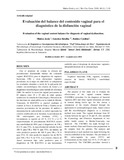| dc.rights.license | http://creativecommons.org/licenses/by-nc-sa/3.0/ve/ | es_VE |
| dc.contributor.author | Muñoz, Jesús | |
| dc.contributor.author | Sánchez, Kiralba | |
| dc.contributor.author | Babino, Cynthia | |
| dc.date.accessioned | 2019-06-04T14:55:36Z | |
| dc.date.available | 2019-06-04T14:55:36Z | |
| dc.date.issued | 2019 | |
| dc.identifier.issn | 0543-517X | |
| dc.identifier.uri | http://www.saber.ula.ve/handle/123456789/45803 | |
| dc.description.abstract | Con el propósito de evaluar la eficacia del procedimiento denominado balance del contenido vaginal (BACOVA) para el diagnóstico de vaginosis bacteriana (VB) y otras alteraciones vaginales prevalentes en la mujer en edad fértil; se compararon los resultados obtenidos a través de la aplicación del estudio cito-morfológico, los criterios de Amsel y el diagnóstico microbiológico como método de referencia (MR). Se analizó la secreción vaginal proveniente de 82 mujeres entre 18 y 45 años de edad, quienes acudieron a la consulta de Ginecología y Obstetricia de dos Institutos de salud pública en la ciudad de Mérida- Venezuela. El BACOVA se practicó mediante el
examen al fresco, la tinción de Gram y Giemsa en las muestras provenientes de las pacientes. El análisis e interpretación de cada método se realizó siguiendo los criterios establecidos en la literatura. La prevalencia de VB, vulvovaginitis por levaduras (VVL) y tricomoniasis se registró en 4,9 %, 17,2 % y 1,2 % respectivamente. El procedimiento BACOVA mostró una sensibilidad del 80% para el diagnóstico de VB y 82,4 % para VVL; la especificidad del método fue del 100 % para VB y 90,8 % para VVL; así mismo, un valor predictivo positivo de 100 % para VB y 70 % para VVL. El valor predictivo negativo fue de 98,7% para VB y 95,2 % en VVL. Los criterios clínicos de Amsel mostraron bajo valor predictivo para el diagnóstico de VB. BACOVA es una herramienta confiable para el despistaje de alteraciones vaginales, independientemente de la sintomatología. | es_VE |
| dc.language.iso | es | es_VE |
| dc.publisher | SaberULA | es_VE |
| dc.rights | info:eu-repo/semantics/openAccess | es_VE |
| dc.subject | Vaginosis bacteriana (VB) | es_VE |
| dc.subject | Vaginitis | es_VE |
| dc.subject | Levaduras | es_VE |
| dc.subject | Criterios de Amsel | es_VE |
| dc.subject | BACOVA | es_VE |
| dc.subject | Sensibilidad | es_VE |
| dc.subject | Especificidad | es_VE |
| dc.title | Evaluación del balance del contenido vaginal para el diagnóstico de la disfunción vaginal | es_VE |
| dc.title.alternative | Evaluation of the vaginal content balance for diagnosis of vaginal dysfunction | es_VE |
| dc.type | info:eu-repo/semantics/article | es_VE |
| dcterms.dateAccepted | Enero 2018 | |
| dcterms.dateSubmitted | Noviembre 2017 | |
| dc.description.abstract1 | The purpose of this study was to evaluate the effectiveness of the vaginal content balance
(VACOBA) procedure for the diagnosis of bacterial vaginosis (BV) and other vaginal alterations prevalent in women during fertile age; for this reason, a comparison of the results obtained through the application of cytomorphological study, Amsel criteria and the microbiological diagnosis as a reference method were made. The vaginal discharge from 82 women between the ages of 18 and 45, who attended the Gynecology and Obstetrics department of two public health centers in Merida-Venezuela, was analyzed. The VACOBA was made through wet- mount method, Gram and Giemsa stain preparations in the samples from the patients. The analysis and interpretation of each method was made following the criteria established in the literature. The prevalence of BV, vulvo-vaginitis by yeasts (VVY) and trichomoniasis in this study was 4.9 %, 17.2% and 1.2
% respectively. The VACOBA procedure showed a sensitivity of 80 % for the diagnosis of BV and 82.4% for VVY; the specificity of the method was 100 % for BV and 90.8 % for VVY. Likewise, a positive
predictive value of 100 % for BV and 70 % for VVY. The negative predictive value was 98.7 % for BV and 95.2 % for VVY. Amsel's clinical criteria showed low predictive value for BV diagnosis. VACOBA is a reliable tool for the screening of vaginal alterations, independently of the symptomatology. | es_VE |
| dc.description.colacion | 3-10 | es_VE |
| dc.description.frecuencia | Semestral | |
| dc.identifier.depositolegal | pp195802ME1003 | |
| dc.identifier.edepositolegal | ppi201202ME4102 | |
| dc.identifier.eissn | 2244-8845 | |
| dc.publisher.pais | Venezuela | es_VE |
| dc.subject.facultad | Facultad de Farmacia y Bioanálisis | es_VE |
| dc.subject.institucion | Universidad de Los Andes (ULA) | es_VE |
| dc.subject.keywords | Bacterial vaginosis (BV) | es_VE |
| dc.subject.keywords | Vaginitis | es_VE |
| dc.subject.keywords | Yeasts | es_VE |
| dc.subject.keywords | Amsel’s criteria | es_VE |
| dc.subject.keywords | VACOBA | es_VE |
| dc.subject.keywords | Sensitivity | es_VE |
| dc.subject.publicacionelectronica | Revista de la Facultad de Farmacia | |
| dc.subject.seccion | Revista de la Facultad de Farmacia: Artículos Originales | es_VE |
| dc.subject.thematiccategory | Medicina y Salud | es_VE |
| dc.subject.tipo | Revistas | es_VE |
| dc.type.media | Texto | es_VE |


